Food Work
Seems like a good week to talk to a food and gender scholar
Why do we make such a big deal about physical presence at Thanksgiving? Maybe, at least in part, because a lot of us are really bad at showing up and being together in our day-to-do pre-pandemic existences. And why are we so bad at it? A lot of reasons, but we work too much (out of necessity, out of compulsion, out of fear) and we fetishize busy-ness. Thanksgiving and Christmas are the only two times when non-essential American workers either 1) reliably have work off or 2) feel like they feel like they can actually lean in to not working.
As a result, these two holidays become overdetermined loyalty tests: if you love me, if you care for me, you will show up to Thanksgiving. Before the pandemic, it was “you will show up for Thanksgiving, even if it costs too much to get home, and even if your experience in the home is toxic”; now, for those who are still demanding Thanksgiving fealty, it’s “you will show up to show me you love me more than you’re scared of this virus” (or, “you will show we share a political world view that is anti-science and individualist).
Which is all to say: there’s a lot we’re not talking about when we talk about Thanksgiving — more specifically, our understandings of food, gender, control, and care. Which is why I wanted to spend some time this week with Dr. Emily Contois, who’s been thinking about these ideas for well over a decade. She’s the author of Diners, Dudes, and Diets: How Gender and Power Collide in Food Media and Culture (buy it here!) and a media studies professor at University of Tulsa. (My visit to campus last year was what sparked this post on the coolification of mid-size cities). She is also a generous and incredibly effective teacher, and I’m always delighted and surprised by her work — and you will be too.
(If you have questions for Emily, please leave them in the comments; please forgive the surplus of “Women looking delighted to serve Thanksgiving” images; I was on a Getty spree. Finally, there is a brief discussion of disordered eating below, if that’s something you’d like to avoid.)
You took a really interesting route to academia and food studies. Can you tell me more about it as a segue into the work you do now?
It all started in college, when I studied Letters. It was a wonderfully flexible major with courses in history, literature, philosophy, and languages, one ancient (Latin, which was where I met my husband!) and one modern, Italian. I was always interested in food, nutrition, health, and culture, so this nimble coursework made it so I could explore those intersections, especially with the addition of a minor in Medical Humanities. I thought I wanted to become a dietitian, so I took biology, microbiology, physiology, and chemistry too. My own education is part of why I’m such a strong advocate for the liberal arts in today’s higher education landscape.
Instead of going into dietetics, I choose public health nutrition at UC Berkeley to study population level health and nutrition issues, rather than individual ones. I was fascinated by the workplace as a public health site, given how many Americans are culturally defined by working hard, comprising a patriotic virtue. I spent a few years in worksite wellness, hoping that if we created truly health-promoting workplaces, I might be doing something that would help make the world a better place.
I still believe, strongly, in public health as a human right. And as we’ve lived through this pandemic, I’m grateful for my basic training in epidemiology and infectious diseases. But in my day-to-day work, I found myself missing more interdisciplinary thinking. I missed teaching (which I’d gotten to do the entire time I was at Berkeley) and generally, I felt a pull back into academia. I was happiest when I started reading cultural theory for fun in the evenings. I started researching the cultural meaning of trophy kitchens, which eventually turned into something. I knew I wanted to teach and to research, even if it meant leaving a good and stable job.
So, I went back for a second master’s degree, this time in Gastronomy at Boston University in the program founded by Julia Child and Jacques Pepin for the academic study of food. I loved every minute of it, though I worked nearly full time as a contractor with my previous job in order to pay for it. I wrote my thesis on masculinity and dieting, and then applied for a PhD, which I pursued in American Studies at Brown University. I expanded my research beyond just dieting to focus on food branding, cooking, and the broader food media environment.
At the same time, I knew that my hope to become a professor didn’t match the realities of the academic job market. So I also said yes to every opportunity that came my way. I reported stories for the food section of the newspaper in Providence. I wrote for a food website and for Nursing Clio, a peer-reviewed blog on the history of medicine and gender. I presented at foodie events. I gave talks at women’s wellness conferences. I worked part time as an assistant instructional designer for online courses. I blogged. I set up blogs for other writers. I developed a social media presence. Luckily, things worked out and I landed a tenure-track position, but every step of the way, I knew that might not happen.
We hear lots of talk about the value of interdisciplinarity, but then the academy often encourages you to choose a discipline so you’ll be “legible” to more traditional fields. I didn’t do that. From my “interesting” path, I’ve trained to think, work, and communicate across disciplinary boundaries, with folks both inside and outside of academia, and to write for various audiences.
It might not sound like much of a compliment, but when a mentor read my final book manuscript, he described it as “an example of what a true generalist can achieve … truly interdisciplinary in a way that few works actually are.”
Your book uses the figure of the “dude” to talk about various reactions to the perceived emasculation of The Great Recession. I don’t think most people automatically connect gendered attitudes and discourses around food and economic instability, but given our current moment, I want to hear a whole lot more about how we ideologically compensate and react to precarity.
While our current recession is affecting women, particularly Black and Latina women, to a greater degree, the Great Recession was referred to as a Mancession or Hecession for how job loss and unemployment were greater among men. That caused a gender crisis, given how normative masculinity is often defined by breadwinning and professional success, ambition and control.
The idea of the self-made man is always an ideal and out of reach for most men. That’s part of why Donald Trump loves to frame his career in such terms, and why it resonates with the many men who voted for him in both 2016 and 2020. But the Great Recession made it impossible for some men to achieve such masculine norms — especially for Millennials, some of whom found themselves without jobs, without the ability to buy a home, or even having to move back in with their parents. For some men this meant renegotiating their sense of masculinity within the home and with domestic duties, like cooking, cleaning, and parenting, which even within egalitarian relationships, are still coded as somewhat feminine and feminizing.
Some men reacted to this domesticated downturn with violence and anger. The dude was a different —but just as reactionary — response. Instead of lashing out, the dude slacks off and disengages with a touch of irony and a dose of humor. Rather than aspire to greatness, he celebrates averageness. The dude expresses purposefully arrested development as a self-protective measure, to withdraw rather than fail to achieve twenty-first-century manliness. The dude rebelliously refused to step out into a future far less bright than expected.
In the book, I show how the food, media, and marketing industries manipulated and sustained the dude’s carefree ethos as they sought to convince men to engage in supposedly feminine activities, like buy cookbooks or drink diet soda or go on Weight Watchers. Aligned with the dude, men could do such things, but with so little enthusiasm or investment that the power and boundaries of conventional white masculinity remained intact.
For men during the Great Recession, the cultural message was, “Don’t worry, you’re still a real man.” The dude was about protecting the status of white masculinity in a moment of economic precarity when some men couldn’t fulfill its social expectations. For women during our current recession, I’m seeing a somewhat similar message, “Don’t worry, you’re still a good woman,” but with different consequences. There’s no dude-ish forgiveness for women. Instead, it’s about ensuring that the social expectations of femininity remain fulfilled. The demand to do it all and make it work hasn’t waned, but brands purport they’re here to help, whether with more eco-friendly paper plates or curbside grocery pick-up or plant-based snacks delivered to your door.
Given the intimate nature of food in our everyday lives, it lays bare the inequities of our broader social experiences. That was clear in the Great Recession, and it will prove so again with this recession.
You open the book with a description of your grandmother, diligently preparing Thanksgiving dinners and other family feasts, but so regimented in her attitude towards food and her own appetites. I think a lot of women are familiar with this image. Can you unpack it a bit? That edge between providing abundance but denying it for yourself?
Women have been socialized to believe that food is love, a message that the food advertising industry has fervently reinforced for well over a century. Food can be a powerful way to express love and signs of genuine affection. But food is also labor that is all-too-often uncompensated and unrecognized. Sociologists call this “food work.”
And it’s not just cooking. It’s finding recipes that everyone at the table likes, or at least will eat. It’s mentally keeping track of what’s in the pantry and what needs to be purchased. It’s grocery shopping. It’s cleaning up. It’s trying to reduce a household’s food waste and manage a potentially tight budget. Society often views women as a gatekeeper for health too — the one who buys organic options to protect children from pesticides and preservatives or who limits fat and salt in order to keep their husband’s triglycerides and blood pressure in check, and feeds everyone nutritious meals to ensure they stay well.
This mounting, gendered responsibility is particularly true at Thanksgiving. For some women, this is a wonderful holiday—and from a food studies perspective, there is deep cultural meaning to cooking family recipes, keeping traditions alive, and breaking bread together. For other women, preparing Thanksgiving is hugely stressful, an expected duty they feel they can’t shirk. Regardless of whether food work feels oppressive or pleasurable to any individual woman, our culture venerates it as part of good womanhood. To opt out of food work poses a social transgression for women, though that’s starting to lessen, which is a good thing.
Women experience this mandate to feed others at the same time that they absorb the message that women are more valued, and valuable, when they are beautiful, especially when they are also thin. Again, sociologists give us the term “beauty work” to describe the labor of doing things like hair and makeup. In some ways, this work produces value, given the way society acknowledges feminine beauty. But beauty work also diminishes women’s ability to generate value, because of the literal time and energy these practices take. The same rule applies to the time and energy it takes to diet, or “eat clean” for that matter, to constantly watch what you eat.
The work of idealized womanhood lies at this complex intersection of feeding others out of love, while denying our own appetites to feed ourselves so we’ll be thin and considered lovable. I explore how men’s relationships with their bodies are increasingly strained too, but women remain disproportionately affected by these dynamics.
Like a lot of women, including Taylor Swift, I had a period of disordered eating in my late teens and through my 20s. I personally don’t think you ever really shake some of the ideas about food and body that you internalize and manifest in disordered eating — you just learn to manage them. You also become very attuned to the ways those attitudes manifest.
That’s a preamble to saying that I’ve subconsciously avoided conversations about “intermittent fasting” (or IF, as it’s often referred to) because I knew they would piss me off….and then I happened upon a Facebook thread where people were recommending IF tips using so much of the language I recognized from basically teaching myself not to be hungry, language that we’ve come to understand as unhealthy and disordered, but is now acceptable because it’s cloaked in the discourses of “wellness” and “optimization.”
How do we decide which body conversations are acceptable, which ones are feminized, which ones can happen in public forums and which ones just get quietly valorized through the late ‘90s fetishization of the Britney Spears stomach? As I said in my piece on Swift’s disordered eating, these sorts of behaviors often hide in plain sight. How do we talk about them? [SIDENOTE: I know there are some medical applications for IF. That’s not what we’re talking about here.]
I can relate to your experience. I trained very seriously to be a professional ballet dancer throughout my childhood and teens, so I dealt with eating disorders and disordered eating for many years. In college, I finally got professional help, at the same time that I researched and wrote my honors thesis on the language of the dieting industry in the early 2000s. I read diet books, women’s magazines, and the “diet” section of chain restaurant menus as cultural texts, and found the frameworks for dieting invoked a secular religiosity with phrases like “guilt-free” and “sinfully delicious,” with all these dichotomies between temptation and salvation.
That was a lightbulb moment for me — that the negative ways I, and so many women, felt about our bodies were purposefully fed to us by the hands of an industry that financially benefited from us perpetually feeling like failures. If we can recognize these destructive messages for what they are, they’re easier to resist. Part of the deception of wellness culture — which I write about as diet culture’s supposedly harmless cousin —is that it makes the messages that diet culture sent overtly harder to identify and parse. But they’re still there. They’re still worth resisting.
I fully recognize, though, that finding peace with food and our bodies is easier said than done. There are days that it doesn’t matter that I have a master’s degree in public health nutrition or that I used to work in worksite wellness or that I’ve literally written a book that addresses diet culture and fat stigma—I still don’t always feel great about my body. That’s how hard this work is. A number of other scholars have similarly pondered how to be a “good feminist” while losing weight or wanting to lose weight.
To your point about intermittent fasting, men and women both follow such practices as a way to manage their bodies, but I see it playing out in distinctly gendered ways within the tech cultures of Silicon Valley. There I see fasting related to Soylent shakes, another solution to just get rid of food altogether — the appetite, the preparation, the eating, all of it. It’s this modern orchestration of cartesian dualism that separates the glorious, masculine, immaterial mind from the gross, feminine, material body. Contrary to the cultural trope of voracious male appetites that need to be satisfied, intermittent fasting seeks to control and triumph over appetite as a sign of masculine strength, to bend the body to the mind’s will.
But dieting and disordered eating, and the blurry spaces where they overlap, including in IF, aren’t just personal behaviors. They’re cultural ones. As I write in my book, I’ve been studying dieting for nearly fifteen years now because it “encapsulates the paradoxes and conflicts at the core of American identity: abundance and restriction, freedom and containment, dreams and expectations. Diets extend and exaggerate advertising’s central promise of aspirational transformation. The public faces of commercial diet programs illuminate American identities, not through what we eat, but through what we aspire so vehemently to limit and avoid.”
This is where taking the long view of history helps us. For more than a century, moments of gender crisis— in the 1890s, the 1950s, the 1980s, and heck, now — go hand-in-hand with extreme anxiety about eating and our bodies. It’s human and rational that we turn to food and to our physical selves to try and regain a sense of control, safety, and security during these times of significant strife. But turning inward to solve hugely complex social problems has never worked out for us. Collective and systemic actions toward global food justice have far more merit.
A few weeks ago, I talked with Dr. Jessica Calarco about sociology as “un-gaslighting.” I think Gender Studies work in a similar way (and of course intersects with sociology all over the place) but I’d love to hear how you think of it illuminating the otherwise invisible or accepted as what they are — constructs — both in your life and your students’ lives.
I teach a Food Media course, and my students confess they start thinking it will be a fluffier elective, but they instead leave stunned by how food reveals so much about structural inequities and lived experiences of oppression, especially gender, but also race, social class, sexuality, citizenship status, regionality, and so on.
For a long time — too long — whenever food studies approached food and gender it was about women and women’s supposedly special relationship with food. My work is genuinely interested in gender and power. Studying men and masculinity revealed a great deal about how these various institutions and industries construct femininity relationally. I saw it most clearly when I compared side-by-side how Weight Watchers marketed the same products and tools to men and women in markedly gendered ways, and how the soft drink industry routinely sought male consumers for diet sodas, and how yogurts were pitched as protein-packed post-workout snacks for men, but sorry dessert substitutes for women on diets.
And this isn’t just on a symbolic level. While women have long used food as a site for political resistance, food can also be deployed to keep women within prescribed boundaries. For example, I couldn’t help but recognize the gender negotiation taking place after Joe Biden named Kamala Harris Vice President. In her first speech after the nomination, and in subsequent interviews, she spoke of how she loves to cook Sunday dinner. For some voters this likely resonated as an “appropriately” feminine interest, one inserted to tamper critiques that she was too ambitious and assertive; to prove she was both woman enough and man enough for the job. The same goes for the way American politics seeks to engage (primarily white) women voters through “kitchen table issues.”
From yogurt marketing to how we are called upon as citizens, patriarchy oppresses all of us. Not in equal measure, but it hurts all of us, including men. Some of the young men I teach grow angry when I discuss masculinity: where it comes from, how it exerts power, how it does damage, and how it could change. And sure, some men on the internet are specifically angry that I’m a woman doing research on men and masculinity. But for the most part, my students understand all of this. Part of it is generational; they have no trouble wrapping their heads around, for example, non-binary gender identities.
Students that self-select my courses understand that gender is a cultural construct. It is only what we make it, through our social institutions and processes, our media, our day-to-day interactions, and so on. Gender as we currently understand it can be re-signified, reconstructed, and reconfigured. Food media and marketing has imposed an awful lot of pain by upholding and enforcing a gender binary onto food products, as well as flavors, ingredients, appetites, our bodies, ideas about health, and possibilities for who we can be and become. My hope is for a far more inclusive food future, full of more justice and more joy. ●
You can buy Emily’s book here, and follow her on Twitter here. I’ll close with this image because it sure does look like the mom is taking her turkey and heading the other direction of her demanding family.
Long interviews like this with (with someone who’s not a celebrity) rarely get published on a mainstream news sites, so if this is the sort of thing you value, and want more of, think about going to the paid version of the newsletter. One of the perks = weirdly fun/interesting/generative discussion threads, just for subscribers, every week, which are thus far still one of the good places on the internet.
If you are a contingent worker or un- or under-employed, just email and I’ll give you a free subscription, no questions asked. If you’d like to underwrite one of those subscriptions, you can donate one here.
You can find a shareable version online here. You can follow me on Twitter here, and Instagram here. Feel free to comment below — and you can always reach me at annehelenpetersen@gmail.com.


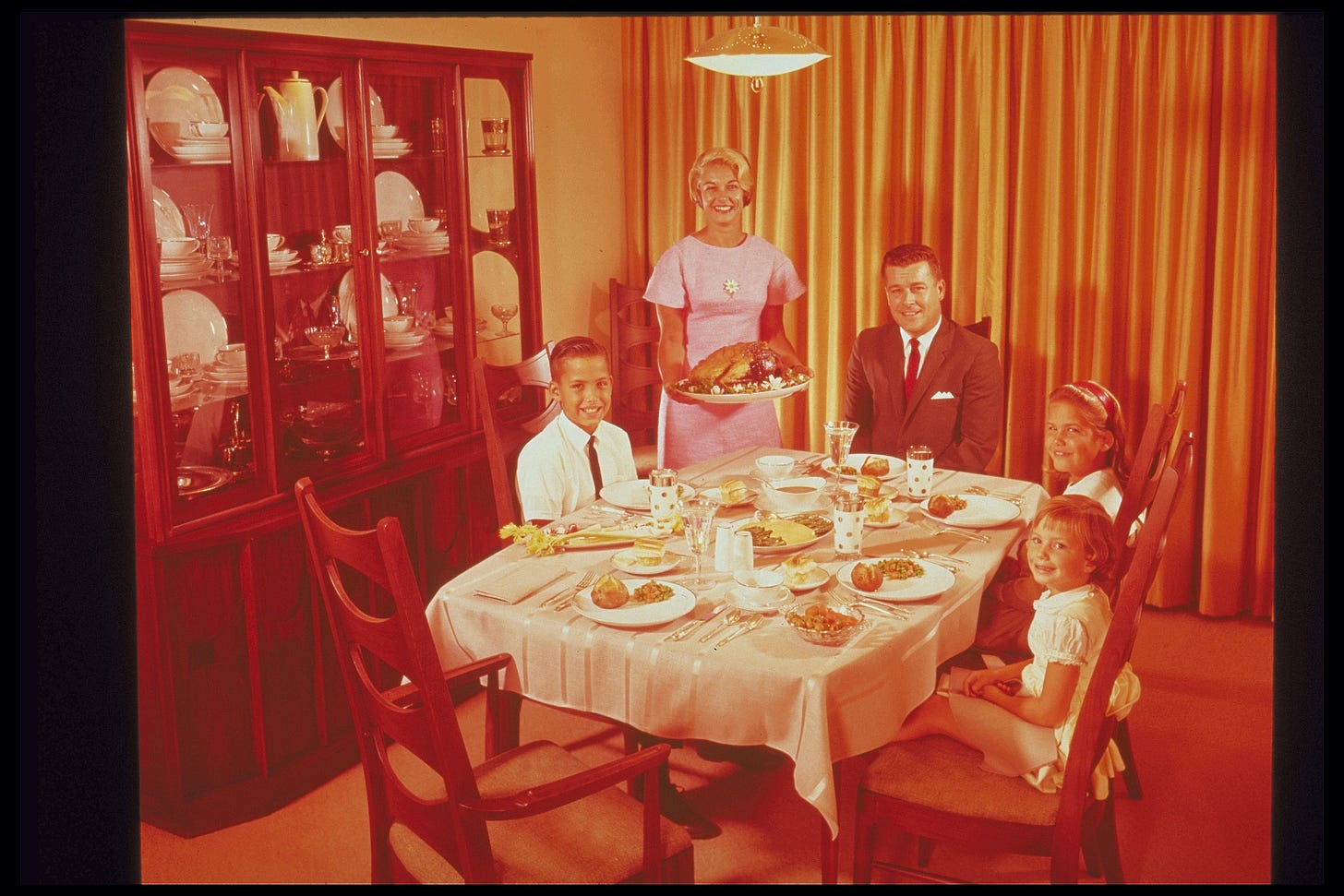
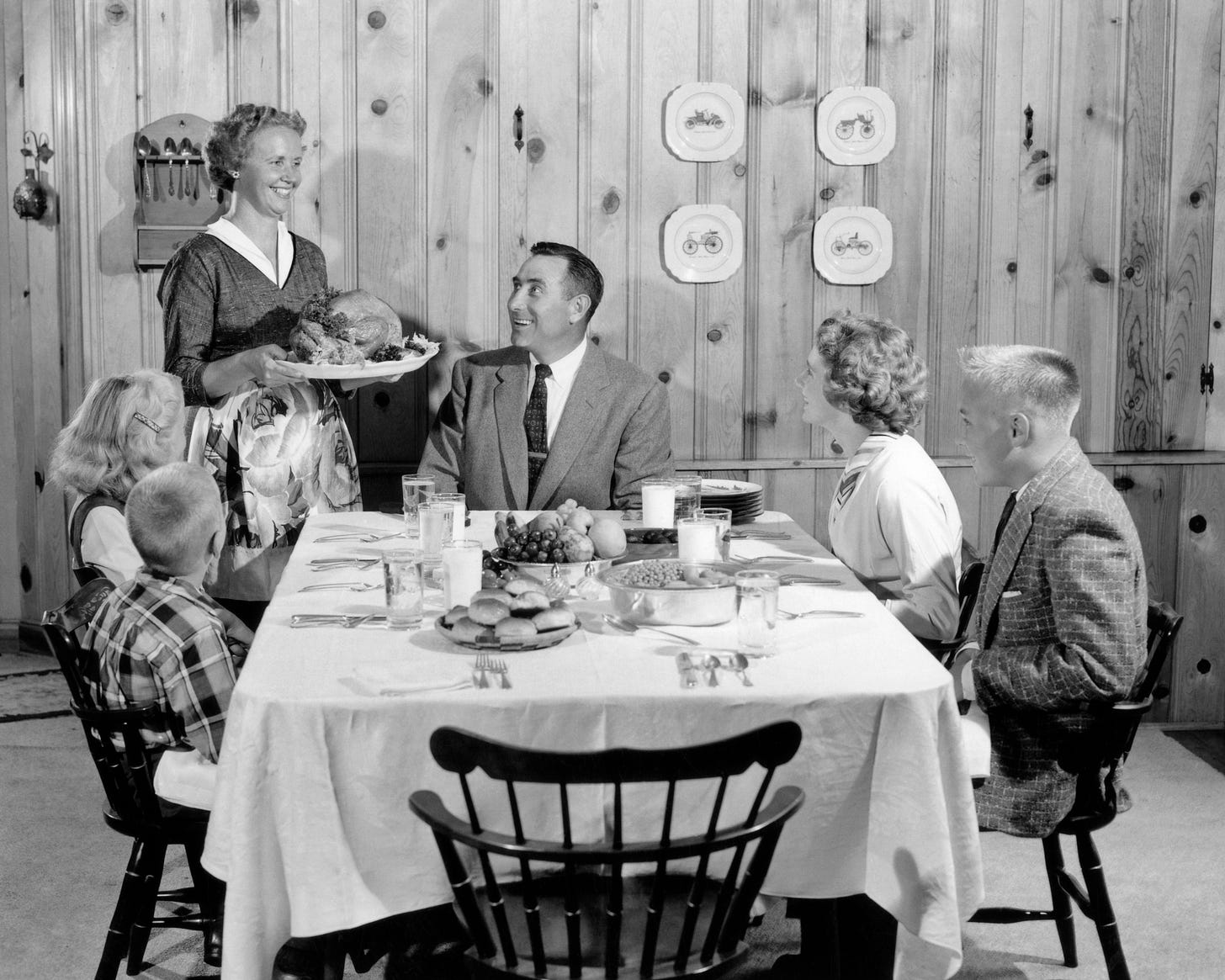
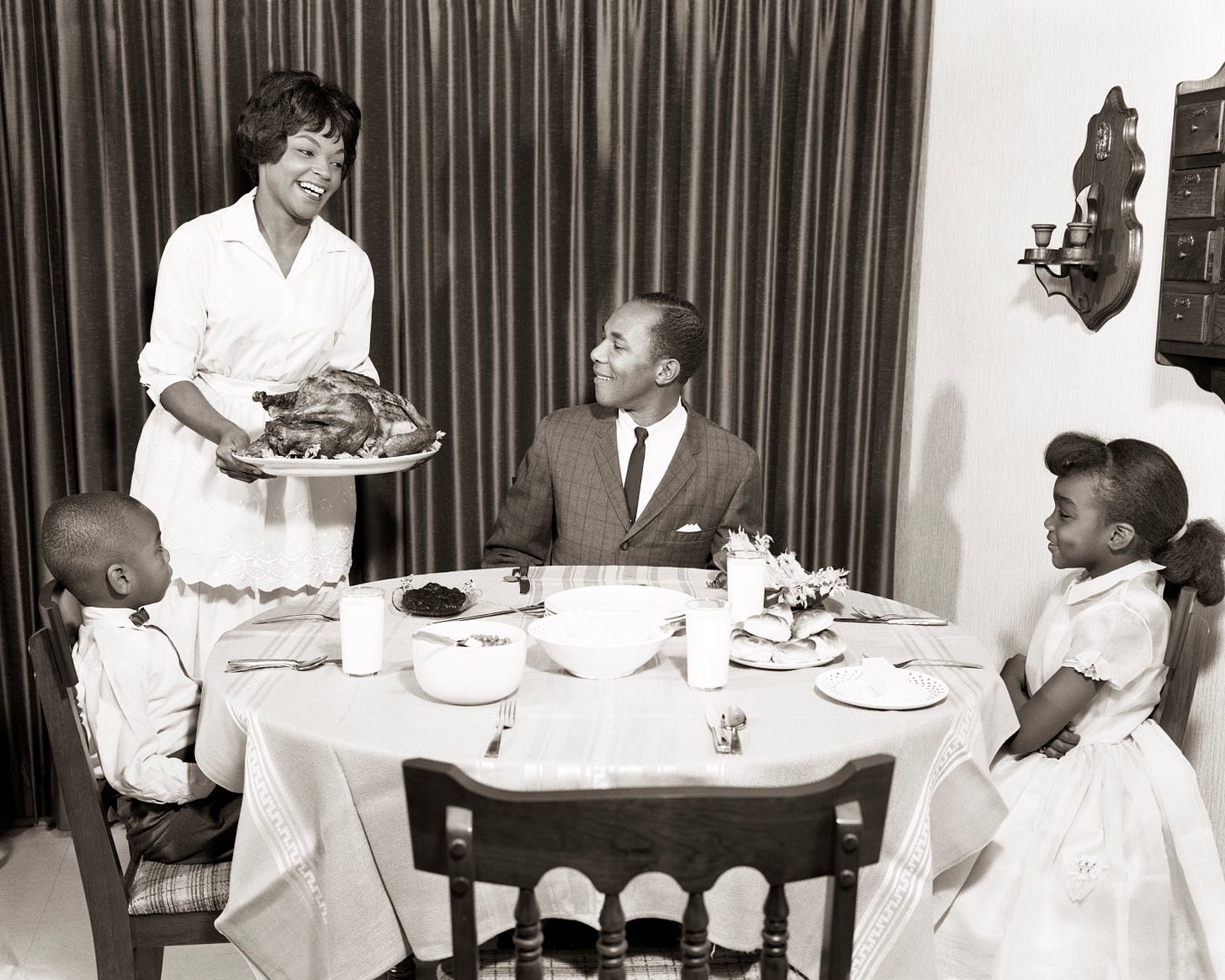
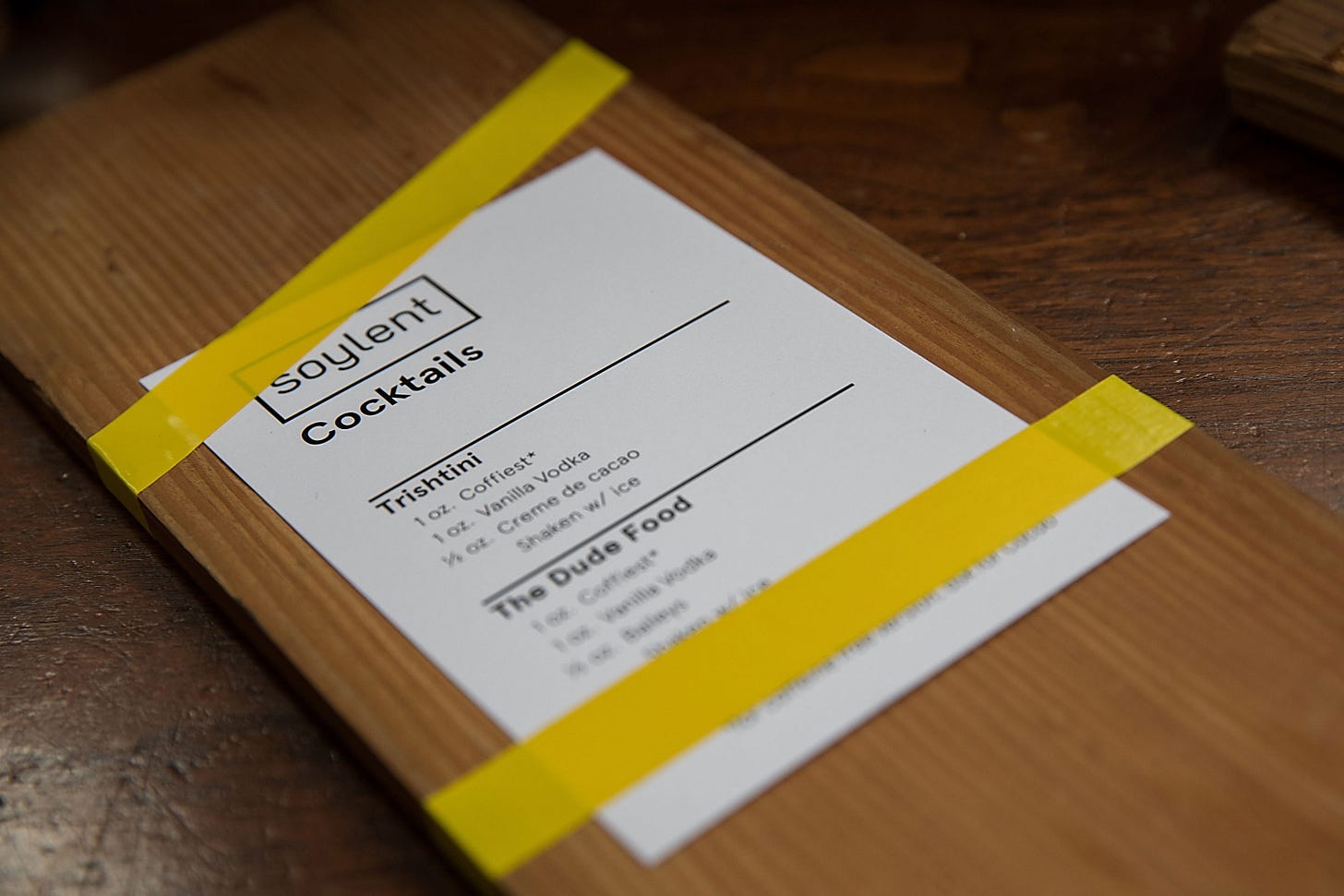

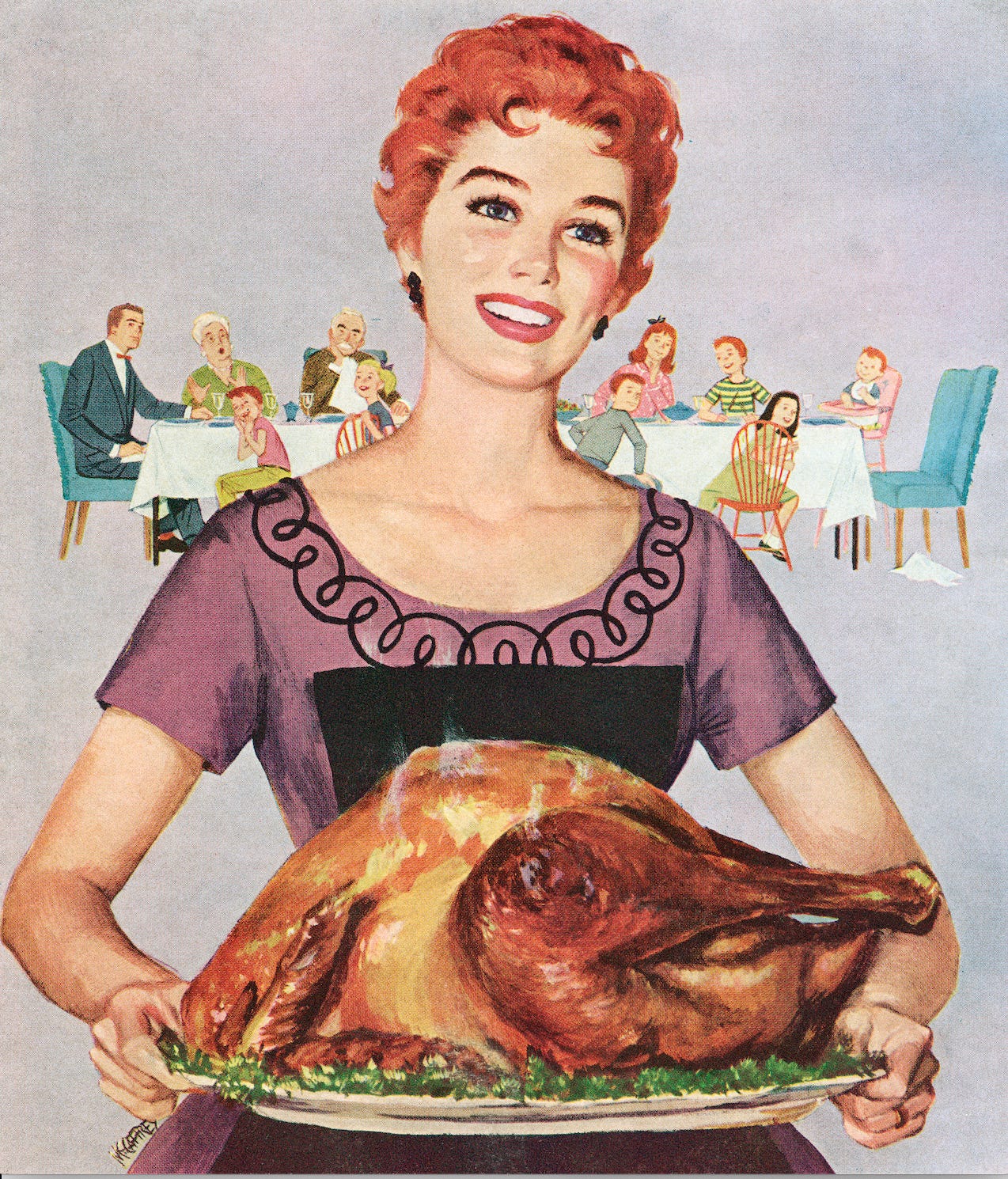

This was so good--please do keep interviewing non-celebrity intellectuals! I don't have much to add, other than that I found the interview insightful and a pleasure to read.
Oh wow, what a fascinating read. I think the link between politics and food is really fascinating, particularly how men use kitchens and cooking to appear more relatable (with often poor results) and women have to play up feminine traits (see Margaret Thatcher cooking for her cabinet colleagues in the Crown).
In the UK, we've had the four ovens scandal: https://www.independent.co.uk/news/uk/politics/james-brokenshire-ovens-two-four-picture-a8913971.html
The two kitchens drama: https://www.bbc.co.uk/news/uk-politics-31875297
And famously, 'eat your cereal' lady of the Scottish independence referendum:
https://www.youtube.com/watch?v=OLAewTVmkAU